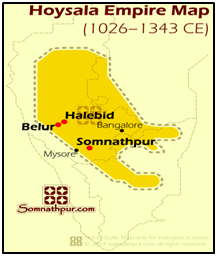Why in News?
- Three Hoysala-era temples in Karnataka [Chennakeshava (Belur), Hoysaleswara (Halebidu) and Keshava Temple (Somanathapura, Mysuru)] recently made it to UNESCO’s World Heritage List, under the collective entry of ‘Sacred Ensembles of the Hoysalas’.
- The announcement was made by UNESCO, during the World Heritage Committee’s 45th session in Riyadh, Saudi Arabia.
What’s in Today’s Article?
- Who were the Hoysalas?
- About the Hoysala Temples
- About the Sacred Ensembles of the Hoysalas
- About the UNESCO World Heritage Sites
Who were the Hoysalas?

- The Hoysalas, which began as provincial governors under the Western Chalukyas, held power in Karnataka from the 10th century to the 14th century.
- The dynasty came to power when the two dominant empires of the South, the Western Chalukyas and the Cholas crumbled.
- The capital of the Hoysalas was initially located at Belur, but was later moved to Halebidu(or Dwarasamudra).
- It was an important period in the development of South Indian art, architecture, and religion.
- The empire is remembered today primarily for Hoysala architecture - ~100 surviving temples are scattered across Karnataka.
- No known monuments other than temples, like palaces or forts, survive from the Hoysala period.
- This is one of the paradoxes of the early medieval and medieval non-Islamic world, because the non-temple buildings were all built in either mud or brick or wood.
About the Hoysala Temples:
- Hoysala temples are known for the rare beauty and finesse of their wall sculptures, and have been described as art which applies to stone the technique of the ivory worker or the goldsmith.
- One notable feature of Hoysala architecture is the use of soapstone, a malleable stone that is easy to carve.
- This is one of the reasons behind the abundance of intricate sculptures (animals, scenes of daily life, depictions from the epics and the Puranas)one can see on the temple walls.
- The temples are generally built on stellate (star-shaped) platforms, and have several structures inside the complex.
- Another special feature of Hoysala architecture is the unique confluence of styles - Hoysala architecture is an amalgamation of 3 distinctive styles (Dravidian, Vesara and the North Indian Nagara style).
- An interesting feature of Hoysala temples is that they are ‘signed’ - the sculptors, masons leave behind their names, and sometimes a few more details.
- These Vaishnava and Shaiva shrines were built at the time Jainism was prominent in the region, and thus mark a turn towards Hinduism.
About the Sacred Ensembles of the Hoysalas:
- Built in the 12th and 13th centuries, the 3 temples selected for the UNESCO list are important not just because they demonstrate their builders’ superior skill, but also because they narrate the tale of the politics that shaped them.
- The Chennakeshava temple (dedicated to Lord Vishnu) was consecrated around 1117 AD by the mighty Hoysala king Vishnuvardhana, to mark his victories against the Cholas.
- It is thus also called the Vijaya Narayana temple.
- The Kesava temple (also a Vaishnava shrine) was built in Somanathapura in 1268 by Somanatha, a general of Hoysala King Narasimha III.
- It is built in the shape of a 16-point star and has 3 shrines dedicated to Keshava (the statue is missing now), Janardhana and Venugopala.
- The Hoysaleswara temple is believed to be the largest Shiva temple built by the Hoysalas, and is dated to the 12th century.
About the UNESCO World Heritage Sites:
- A World Heritage Site (WHS) is a landmark or area with legal protection by an international convention administered by the UNESCO under the UNESCO World Heritage Convention, established in 1972.
- These sites are designated by UNESCO for having cultural, historical, scientific or other forms of significance.
- The sites, classified as cultural, natural and mixed (meeting both cultural and natural criteria) heritage around the world, are considered to be of outstanding value to humanity.
- To be selected, a WHS must be a somehow unique landmark which is geographically and historically identifiable and has special cultural or physical significance.
- For example, WHSs might be ancient ruins or historical structures, buildings, cities, deserts, forests, islands, lakes, monuments, mountains or wilderness areas.
- These sites are demarcated by UNESCO as protected zones and the list is maintained by the international World Heritage Program administered by the UNESCO World Heritage Committee.
- As of September 2023, A total of 1,199 WHSs exist across 166 countries.
- With 59 selected areas, Italy is the country with the most sites on the list; China is the second with 57 sites
- Presently, there are 42 WHSs (including 3 Hoysala-era temples) located in India (out of these, 34 are cultural, 7 are natural and 1 is mixed).









